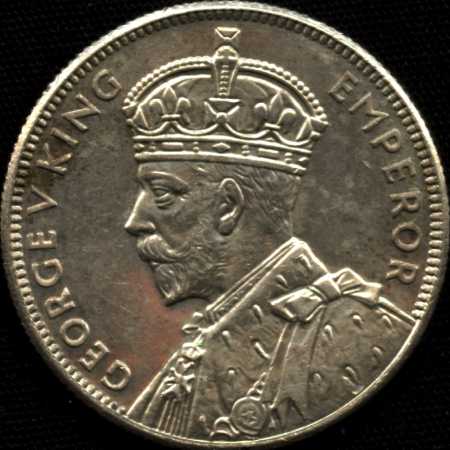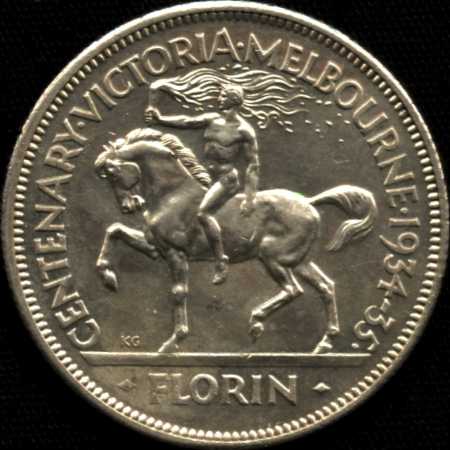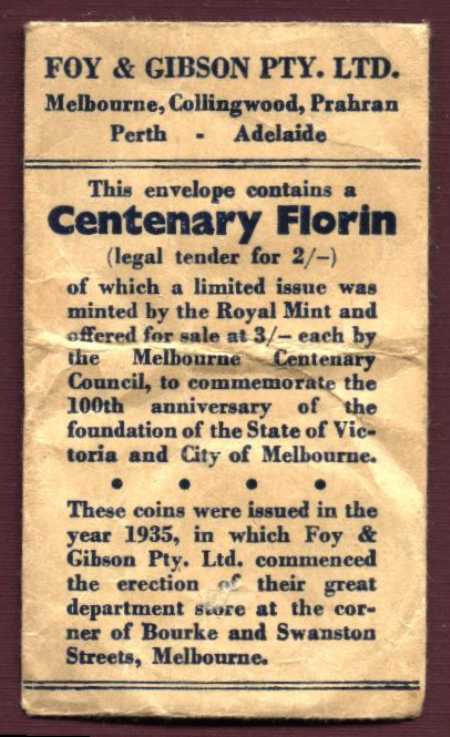Melbourne Centenary Florin 1935 coin



Paper envelope in which Foy & Gibson presented Melbourne Centenary florins to
some of its customers.
An article titled "Collector or Numismatist" by Alan H. Collis in the
July 1971 issue of The Australian Coin Review dealt with the history of the coin
itself and of the early settlements on Port Phillip Bay. What follows is an excerpt
from that article and is reproduced here with the permission of Australasian Coin
and Banknote Magazine, the current copyright holder.
A search through the daily newspapers of the period provides us with some interesting information
On 21 June 1934 we read in the Argus:
Centenary Florins to be Struck
Arrangements have been made between Centenary officials and
representatives of the British Treasury and the Commonwealth Government for the
minting of special Commemorative Florins
Negotiations have been completed for the minting of a limited
number of florins which are to be sold and distributed by the Centenary Council.
It was expected that these coins would be sold at more than face value and that
the profits from the sale would be granted to the Centenary Council.
All costs additional to the coinage of the florin would be
borne by the council, these costs include the provision of a special die and would
probably amount to £100.
No limit has been placed on the number of coins available,
but if an excessive number were issued, their value to collectors and dealers would
decrease. In any case, these coins would be available for use as normal currency
at face value.
The design selected by the finance committee was submitted
to the Governor-General, Sir Isaac Isaacs, for approval.
The Chairman of the Art Committee, Mr Russell Grimwade, criticised
the Official Centenary Emblem depicting a nude male figure seated on horseback and
bearing a flaming torch, which it is proposed to stamp on the back of the coin.
This design, said Mr Grimwade, was chosen when the Council was in its infancy, perhaps
it is appropriate because it looks worth about two shillings.
On 15 February 1935 the Argus printed the following:
Centenary Florin Sales are Dragging
To date only 11,000 of the 75,000 minted have been sold and
the committee naturally were getting somewhat unsettled as most of the books, medals,
etc., have not been well received by the public.
Then on 17 May 1935 there appeared:
Centenary Florins bought by American Collectors
Several hundred Centenary Florins have been purchased recently
by overseas collectors, principally in the United States. The sale of florins is
progressing slowly however, and about 60,000 of the 75,000 remain on hand. Recently
the sale of the florins at three shillings each at the town hall has been averaging
about 100 per week. At this rate, it would be at lest 12 years before the last florin
was disposed of. It is understood, however, that in six weeks time any florins that
have not been sold will be melted down.
The following was printed on 22 June 1935:
Improved Demand on Florins
So as to facilitate the purchase of these florins, the Centenary
Committee decided it would be easier if the public did not have to go into the Town
Hall and go upstairs but it presumed it would be easier if they were purchased over
the counter from the Licensed Vehicles Office on the ground floor of the Town Hall.
A small footnote reads:
A company has an option on 30,000.
Presumably this company was Foy and Gibson. The article continues:
In the last few days there has been an increased demand from
the public but at this date 33,000 still remains to be sold.
The following information, although not from the newspaper of
the day, is also relevant.
On the assumption that this figure of 33,000 is after Foy
and Gibson received their florins, a further 12,000 would therefore have been sold
in order to leave the quantity of 21,000 for remelting.
As far as I can establish, the coins were mainly available
through the Centenary Committee's outlet at the Melbourne Town Hall and through
the Foy and Gibson organisation. The State Savings Bank of Victoria also distributed
the coins from selected country branches of the bank including all the larger towns.
The 30,000 florins acquired by The Foy and Gibson organisation
were purchased at three shillings each, placed in small paper bags especially prepared
for the purchase, and issued to Foy's customers throughout Australia, at face value,
as change from their purchases. Thus Foy's advertising scheme cost them one shilling
per coin. Today, Centenary florins in Foy's bags are sought after by collectors.
...
The obverse was designed by Percy Metcalf and is the only
design by this artist in the Australian Commonwealth series, although this same
design was used on Rhodesian, New Zealand and Fijian coinages. The horse and rider
reverse was designed by George Kruger Gray, well known amongst Australian coin designers.
The horse represents the last century which was one in which horses played a very
important part in exploration, settlement, cultivation and development of every
industry in Victoria. The raised fore-hoof indicates no limit to future progress.
The nude rider represents young Victoria grown to manhood and the torch is a symbol
of progress and enlightenment.
And what does the Florin commemorate? It commemorates the
Centenary of the first permanent settlement within Victoria, firstly at Portland
Bay in 1834, and secondly, at Melbourne in 1835. So therefore the significance of
this coin is that it identifies itself with the very reason for our being here and
our existence in our City of Melbourne. So, also, the reason for the words 'Victoria'
and 'Melbourne' on the coin, also the double date of 1934/35.
Other Articles
The coinage of the Australian colonies 1788-1909
The coinage of the Internment Camps

